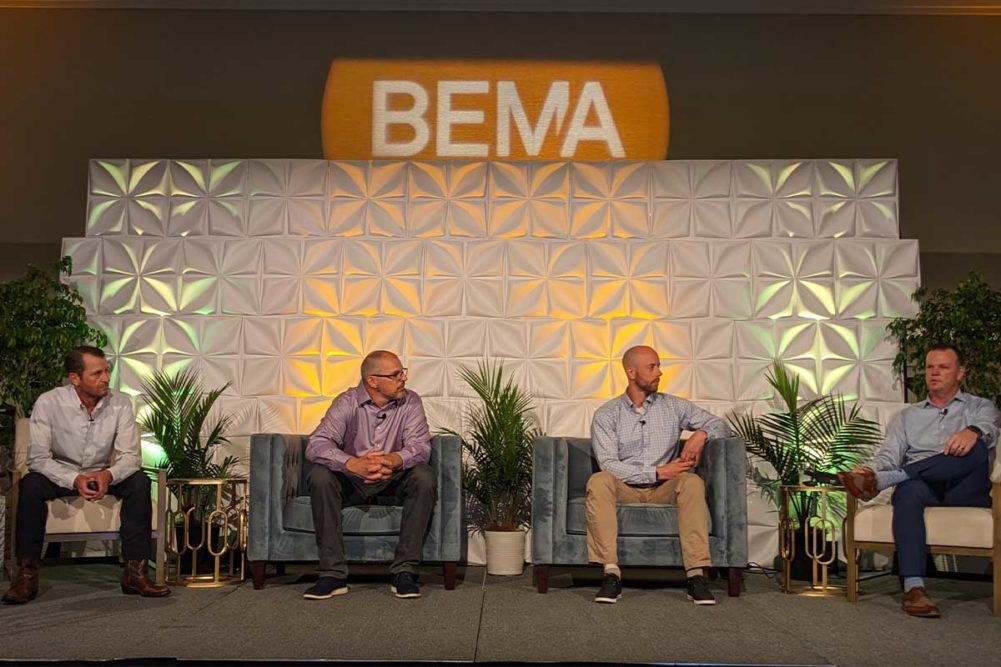PALMETTO BLUFF, SC — One of the greatest technological adoptions seen in the commercial baking industry from the COVID-19 pandemic was the use of telepresence devices for remote maintenance. With bakeries closed off to visitors and original equipment manufacturers (OEMs) limiting travel, remote troubleshooting was necessary to keep baking plants running. Through this adoption, however, other benefits and challenges were discovered as well, as a panel at BEMA’s annual convention, held June 20-25, pointed out.
Justus Larson, senior director of operations at Franz Family Bakeries, Portland, Ore.; Jason Stricker, vice president of sales and marketing, Shick Esteve; Karl Thorson, corporate global food safety and sanitation manager, General Mills, Minneapolis, and Mike Lavalle, corporate account manager, Intralox, shared their experiences using telepresence devices over the past few years to not only keep their facilities running but also take advantage of new opportunities these devices provide.
Telepresence devices allow users to remotely interact with people in another location as if they were physically in the same room. Initially many bakeries adopted this technology to allow service technicians from OEMs to walk onsite maintenance operators through troubleshooting when equipment broke down during the pandemic. Even without quarantines in place, bakeries and OEMs have continued to use these devices for simple fixes to equipment while saving money and time associated with travel costs.
“It’s a tool for real-time troubleshooting,” Mr. Lavalle said. “We don’t need video or pictures that need to be approved. The customer can put on the glasses, show our people the equipment and conveyors, and they can solve the issue right then and there. This is a game changer for our technical support team.”
Not only can telepresence devices save time and money, but they can also be used for remote training, factory acceptance tests and customer audits. The act of putting onsite operators in the place of the service technician — doing the maintenance themselves at the guidance of the OEM —bakeries have also found these devices to be tools for training.
“How much easier is it to learn something when you’ve fixed it yourself rather than when someone else fixes it and then walks you through what they did?” Mr. Larson asked. “They get that hands-on experience as they’re being coached through it.”
Video recording features have also allowed bakeries to use these devices’ recording capabilities to make their own training videos and disseminate institutional knowledge.
“It offers a lot of opportunities for new employees and also those who just need a refresher,” Mr. Stricker said. “A maintenance person can see what they need to do, the way to do it correctly right there, and that makes it easier to get that task done and make sure it gets done correctly.”
Not all telepresence devices are alike, however, and the baking industry has found that some are not suited for the baking industry. Issues of food safety, safety when it comes to combustible dust in bakeries as well as employee eye and hearing safety have been a concern.
Mr. Larson, Mr. Stricker, Mr. Thorson and Mr. Lavalle all have had success with the RealWear HMT technology, which was originally developed for the oil and gas industry. The device allows for all the safety gear a bakery operator may need: hard hat, bump cap, eye wear and hearing protection. The device is rated for the combustible environment of the bakery, and it’s hands-free, voice-activated and allows multiple people to be on a call.
“It’s Facetime on steroids essentially,” Mr. Larson said. “It keeps the line of sight open. They need to be able to see what they’re doing yet they can still use both hands, be completely cognizant of their surroundings and hear someone coach them through that call.
“This is an industrial device that’s made for being on a manufacturing floor,” he added. “It’s explosion proof, so out of all the options we tried, we hadn’t found anything else that fit all of our needs.”






